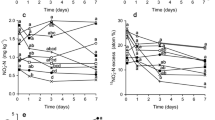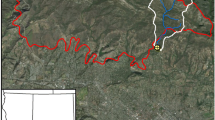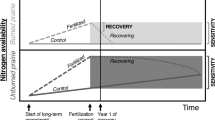Abstract
Wildfires often modify soil properties, including the N status and net N mineralization rates, but their impacts on gross N fluxes have been scarcely evaluated. We aimed to ascertain the immediate effects of a medium–high severity wildfire on soil N transformations. Net and gross N rates were analytically and numerically (FLUAZ) quantified in burned (BS) and unburned (US) topsoils from the temperate–humid region (NW Spain). Analytical and numerical solutions were significantly correlated for both gross N mineralization (m) (r 2 = 0.815; p < 0.001) and gross nitrification (n) (r 2 = 0.950; p < 0.001). In BS, all NH4 +-N fluxes (net m, gross m and gross NH4 +-N immobilization, ‘ia’) increased, while those of NO3 −-N decreased (gross n and gross NO3 −-N immobilization, ‘in’) or did not vary (net n). In US and BS, gross m (0.26–3.60 and 4.70–15.42 mg N kg−1 day−1, respectively) predominated over gross n (0.026–2.45 and 0.001–0.002 mg N kg−1 day−1, respectively), and the same was true for the net fluxes. Compared with the few available data on recently burned soils (m = 8–55 mg N kg−1 day−1; n = 0.50–1.83 mg N kg−1 day−1), our gross m and n rates were similar and very low, respectively; gross n showed that nitrifiers were active in US and also in BS, despite the 98 % reduction observed immediately after the fire. For gross fluxes, m increased more than ia suggesting an NH4 +-N accumulation, but there is no risk of NO3 −-N leaching because n decreased more than in.



Similar content being viewed by others
References
Acea MJ, Carballas T (1996) Changes in physiological groups of microorganisms in soil following wildfire. FEMS Microbiol Ecol 20:33–39
Anderson IC, Poth MA (1998) Controls on fluxes of trace gases from Brazilian cerrado soils. J Environ Qual 27:1117–1124. doi:10.2134/jeq1998.00472425002700050017x
Aranibar JN, Macko SA, Anderson IC, Potgieter ALF, Sowry R, Shugart HH (2003) Nutrient cycling responses to fire frequency in the Kruger National Park (South Africa) as indicated by stable isotope analysis. Isot Environ Healt S 39:141–158
Ball PN, MacKenzie MD, DeLuca TH, Montana WEH (2010) Wildfire and charcoal enhance nitrification and ammonium-oxidizing bacterial abundance in dry montane forest soils. J Environ Qual 39:1243–1253. doi:10.2134/jeq2009.0082
Barraclough D (1991) The use of mean pool abundances to interpret 15N tracer experiments. I. Theory Plant Soil 131:89–96. doi:10.1007/BF00010423
Bastias B, Huang Z, Blumfield T, Xu Z, Cairney J (2006) Influence of repeated prescribed burning on the soil fungal community in an eastern Australian wet sclerophyll forest. Soil Biol Biochem 38:3492–3501. doi:10.1016/j.soilbio.2006.06.007
Bodí MB, Mataix-Solera J, Doerr SH, Cerda A (2011) The wettability of ash from burned vegetation and its relationship to Mediterranean plant species type, burn severity and total organic carbon content. Geoderma 160:599–607. doi:10.1016/j.geoderma.2010.11.009
Certini G (2005) Effects of fire on properties of forest soils: a review. Oecologia 143:1–10. doi:10.1007/s00442-004-1788-8
Close DC, Davidson NJ, Swanborough PW, Corkrey R (2011) Does low-intensity surface fire increase water- and nutrient-availability to overstorey Eucalyptus gomphocephala? Plant Soil 349:203–214. doi:10.1007/s11104-011-0862-3
Dannenmann M, Willibald G, Sippel S, Butterbach-Bahl K (2011) Nitrogen dynamics at undisturbed and burned Mediterranean shrublands of Salento Peninsula, Southern Italy. Plant Soil 343:5–15. doi:10.1007/s11104-010-0541-9
DeLuca TH, MacKenzie MD, Gundale MJ, Holben WE (2006) Wildfire-produced charcoal directly influences nitrogen cycling in ponderosa pine forests. Soil Sci Soc Am J 70:448–453. doi:10.2136/sssaj2005.0096
Doerr SH, Shakesby RA, Walsh RPD (2000) Soil water repellency: its causes, characteristics and hydro-geomorphological significance. Earth Sci Rev 51:33–65. doi:10.1016/S0012-8252(00)00011-8
Fisher RF, Binkley D (2000) Ecology and management of forest soils. Wiley, New York
García-Marco S, González-Prieto S (2008) Short- and medium-term effects of fire and fire-fighting chemicals on soil micronutrient availability. Sci Total Environ 407:297–303. doi:10.1016/j.scitotenv.2008.08.021
Gómez-Rey MX, Couto-Vázquez A, García-Marco S, González-Prieto SJ (2013a) Impact of fire and post-fire management techniques on soil chemical properties. Geoderma 195–196:155–164. doi:10.1016/j.geoderma.2012.12.005
Gómez-Rey MX, Couto-Vázquez A, García-Marco S, Vega JA, González-Prieto SJ (2013b) Reduction of nutrient losses with eroded sediments by post-fire soil stabilization techniques. Int J Wildland Fire. doi:10.1071/WF12079
González-Prieto SJ, Villar MC (2003) Soil organic N dynamics and stand quality in Pinus radiata pinewoods of the temperate humid region. Soil Biol Biochem 35:1395–1404. doi:10.1016/s0038-0717(03)00220-7
González-Prieto SJ, Cabaneiro A, Villar MC, Carballas M, Carballas T (1996) Effect of soil characteristics on N mineralization capacity in 112 native and agricultural soils from the northwest of Spain. Biol Ferti Soils 22:252–260. doi:10.1007/BF00382521
IUSS Working Group WRB (2006) World Reference Base for Soil Resources 2006, vol 103. World Soil Resources Report. FAO, Rome
Kaye JP, Hart SC (1998) Ecological restoration alters nitrogen transformations in a ponderosa pine bunchgrass ecosystem. Ecol Appl 8:1052–1060. doi:10.2307/2640960
Khan SA, Mulvaney RL, Mulvaney CS (1997) Accelerated diffusion methods for inorganic-nitrogen analysis of soil extracts and water. Soil Sci Soc Am J 61:936–942
Kirkham D, Bartholomew WV (1954) Equations for following nutrient transformations in soil, utilizing tracer data. Soil Sci Soc Am J 18:33–34
Koyama A, Kavanagh KL, Stephan K (2010) Wildfire Effects on Soil Gross Nitrogen Transformation Rates in Coniferous Forests of Central Idaho, USA. Ecosystems 13:1112–1126. doi:10.1007/s10021-010-9377-7
Koyama A, Stephan K, Kavanagh KL (2012) Fire effects on gross inorganic N transformation in riparian soils in coniferous forests of central Idaho, USA: wildfires v. prescribed fires. Int J Wildland Fire 21:69–78. doi:http://dx.doi.org/10.1071/WF10132
Leduc SD, Rothstein DE (2007) Initial recovery of soil carbon and nitrogen pools and dynamics following disturbance in jack pine forests: a comparison of wildfire and clearcut harvesting. Soil Biol Biochem 39:2865–2876. doi:10.1016/j.soilbio.2007.05.029
Luxhøi J, Fillery IRP, Recous S, Jensen LS (2008) Carbon and N turnover in moist sandy soil following short exposure to a range of high soil temperature regimes. Aust J Soil Res 46:710–718. doi:10.1071/SR08044
Mary B, Recous S, Robin D (1998) A model for calculating nitrogen fluxes in soil using 15N tracing. Soil Biol Biochem 30:1963–1979. doi:10.1016/S0038-0717(98)00068-6
Murphy DV, Recous S, Stockdale EA, Fillery IRP, Jensen LS, Hatch DJ, Goulding KWT (2003) Gross nitrogen fluxes in soil: theory, measurement and application of 15N pool dilution techniques. Adv Agron 79:69–118. doi:10.1016/S0065-2113(02)79002-0
Neill C, Piccolo MC, Melillo JM, Steudler PA, Cerri CC (1999) Nitrogen dynamics in Amazon forest and pasture soils measured by 15N pool dilution. Soil Biol Biochem 31:567–572. doi:10.1016/s0038-0717(98)00159-x
Prieto-Fernández A, Villar MC, Carballas M, Carballas T (1993) Short-term effects of a wildfire on the nitrogen status and its mineralization kinetics in an Atlantic forest soil. Soil Biol Biochem 25:1657–1664. doi:10.1016/0038-0717(93)90167-A
Prieto-Fernandez A, Carballas M, Carballas T (2004) Inorganic and organic N pools in soils burned or heated: immediate alterations and evolution after forest wildfires. Geoderma 121:291–306. doi:10.1016/j.geoderma.2003.11.016
Smithwick EAH, Turner MG, Metzger KL, Balser TC (2005) Variation in NH4 + mineralization and microbial communities with stand age in lodgepole pine (Pinus contorta) forests, Yellowstone National Park (USA). Soil Biol Biochem 37:1546–1559. doi:10.1016/j.soilbio.2005.01.016
Wessel AT (1988) On using the effective contact angle and thewater drop penetration time for classification of water repellency in dune soils. Earth Surf Proc Land 13:555–562. doi:10.1002/esp.3290130609
Acknowledgments
We thank Jorge Benítez and M. Teresa Pérez for their technical assistance in the laboratory. This research was supported by the Spanish Ministry of Education and Science through project number AGL2008–02823. The participation of M.X. Gómez-Rey was supported by a post-doctoral JAE-DOC contract cofinanced by the European Social Fund. The isotopic ratio mass spectrometer was partly financed by the European Regional Development Fund (EU).
Author information
Authors and Affiliations
Corresponding author
Electronic supplementary material
Below is the link to the electronic supplementary material.
ESM 1
(PDF 17 kb)
Rights and permissions
About this article
Cite this article
Gómez-Rey, M.X., Gonzalez-Prieto, S.J. Short-term impact of a wildfire on net and gross N transformation rates. Biol Fertil Soils 49, 1065–1075 (2013). https://doi.org/10.1007/s00374-013-0806-6
Received:
Revised:
Accepted:
Published:
Issue Date:
DOI: https://doi.org/10.1007/s00374-013-0806-6




